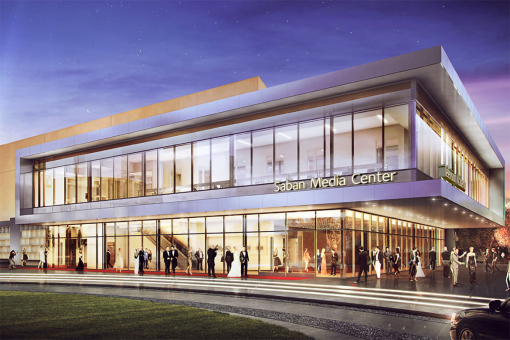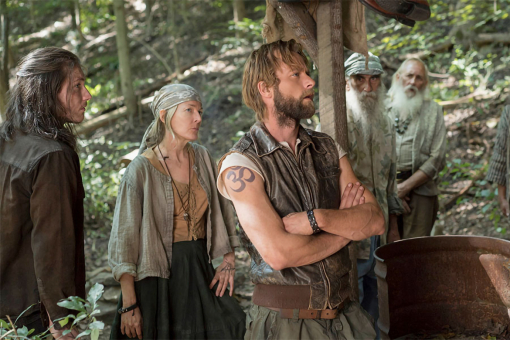The noted fantasy and science fiction writer Ursula K. LeGuin said of TV at its best, that “it could be, it can be, the box of dreams.”
Even with television’s move, literally, outside the box, as viewers watch on phones and laptops and anywhere and everywhere – the box of dreams has never contained more magic. And by next year, the Television Academy will be equipped with a building that is its own box of dreams.
As the Academy closes in on completion of this $30 million building (the focus of the $40 million New Destination Campaign, which also includes a robust endowment for the educational Foundation), it is envisioning all it will mean for the Academy and its Foundation.
“Part of the impetus for the new building was that our industry is still in the midst of a revolution and we needed a space that reflected that,” said Maury McIntyre, Television Academy president and COO.
“We’re in an age where people can not only watch and engage with their favorite shows pretty much anywhere and anytime, but they can also tell their own stories, create their own shows, and distribute them to a wide audience. Never before has television been this personalized – for both the audience and the storyteller. “
With its clean lines and windowed surfaces, the new Academy building will be a place where members can see themselves and their ideas reflected, both literally and figuratively.
As construction continues for an opening in early 2016, the Academy looks not only to continue programs that honor television’s legacy but also launch new programs that talk about where the medium is going. That plan is embodied in the ahead-of-the–curve new building.
The centerpiece of the new 30,000 square-foot Media Center is a reconstructed state-of-the-art Goldenson Theatre, outfitted with full digital connectivity and streaming capability and featuring stadium seating and up-to-date audio and video formats, including 4K and 3D projection, as well as a proscenium stage and green room.
A new Governors Room conference center offers a smart space for smaller gatherings and professional development programs. The space will also include a pocket studio to produce new digital content, an editing suite, as well as new office and meeting spaces for the Academy Foundation’s employees and interns.
The building is, in many ways, the physical embodiment of the Academy’s move not only to embrace the industry’s future but to play an active role in it.
“We want to be more prevalent in the industry, represent more members’ voices and do so on a regular basis,” McIntyre said.
Being forward-thinking is a hallmark of the Academy, and being so means more than the broad-stroke stuff. It means considering every detail of engagement and production. The new Academy building is no exception.
When designing the modernist building, Lee Pasteris, design director for the global design firm Gensler, worked in collaboration with Fred Dagdagan, lead designer for F. Dagdagan Design, and they paid close attention to the fine points of the new space.
For example, the new theater not only contains up-to-the-minute technology, the designers also considered features that may register as more low-tech, like entries and exits.
“I’m really excited about the overall plan, and the indoor and outdoor connection,” said Lee Pasteris. The modern structure boasts clean lines throughout, greater infusion of natural light and a sense of flow for employees, members and visitors. “All of the spaces are more transparent,” Pasteris said.
In their design, Pasteris and Dagdagan considered the Academy’s many large gala events--the Hall of Fame Induction Ceremony, Los Angeles Area Emmys, the College Television Awards and more—and how 600 people will enter and exit the new theater, as well as how they will dine and celebrate outdoors. The first floor’s grand lobby area opens onto the building’s main plaza, where a dinner for hundreds may be held.
“The first level is very transparent [with a full view of the outdoors],” allowing for an elegant flow between the interior and exterior, Pasteris noted.
A circular drive, centered on the Academy’s Emmy statue as its focal point, will allow for graceful drop-off and entry process, as well as the extraordinary Red Carpet events that the Television Academy is known for.
Beyond red-carpet functions, Pasteris said the design team considered the needs for each user – from an event attendee to an individual office user to a sight-seeing group.
The latter group, for example, may find itself in the Hall of Fame courtyard, where the Academy’s famed busts of TV greats will be found. “Giving those a space really helps build a strong historical connection,” Pasteris said, comparing the busts to Hollywood Boulevard’s signature star-tiled Walk of Fame.
And while the Academy honors the past, the future is its focus. The new second floor workspaces offer comfortable spaces for Foundation employees and a technology training center for interns, College Television Award winners, and emerging storytellers, who represent the industry’s next generation.
The building’s design and modern amenities are inspiring the Academy to develop ever more programs for members and for the public to get people thinking.
“The improvements mimic and reflect the evolution of our industry and who we are – thought leaders in our industry – so this building will enable many of our dreams to become reality, as we plan our future,” McIntyre said.
McIntyre added that the first event will be a féte to celebrate the new building’s completion, and beyond that the future is wide open for whatever the Academy can envision. It will be able to dream big as never before, because Pasteris and the design team have tried to think of everything when it comes to the new space.
“Everything’s been designed to be more flexible,” Pasteris said. “We’ve built the space to be adaptive, because we know technology changes.”
The new space will be useful prior to the Emmys for hosting screenings and panel discussions. Beyond awards season, the building’s new potential uses are myriad, and some of the programs to come will get not only members talking, but the industry and its fans as well.
McIntyre cited programs like the recent “Evening with Norman Lear” – at which the TV great was joined by hip-hop artists such as Common, Russell Simmons, and D-Nice to discuss the influence of his television filmography on the birth and evolution of hip-hop – as the type of programs Academy members will see more of.
And they will see them more fluidly and widely, thanks to the coming building’s streaming capabilities.
Academy teams are working tirelessly to develop a slate of events, which will be announced at the opening of the New Media Center and Theatre. McIntyre said that many ideas are on the table, and the Academy is excited that – for the first time – it will have ease in making the programs available to members near and far.
“Every room now will have broadcast capabilities, where before we did not,” McIntyre said. “We want to continue to celebrate and honor excellence in our industry but also talk about where TV is going, how it changes and evolves and what it does for society.”
There are certainly many possibilities to look forward to, and many things that – excitingly – have not even been thought of yet.
“The Television Academy is building a home not only worthy of our organization’s future, but the future of the industry as well,” McIntyre said.
That box of dreams is bursting with possibilities, and just waiting to be opened.













